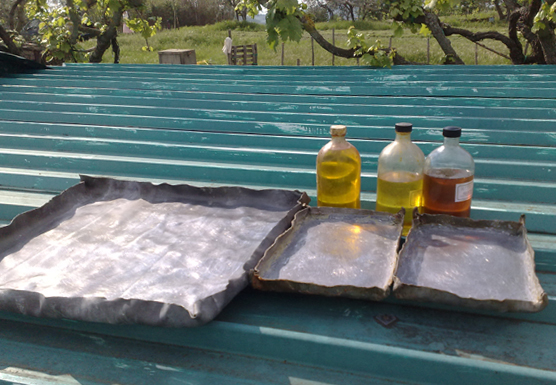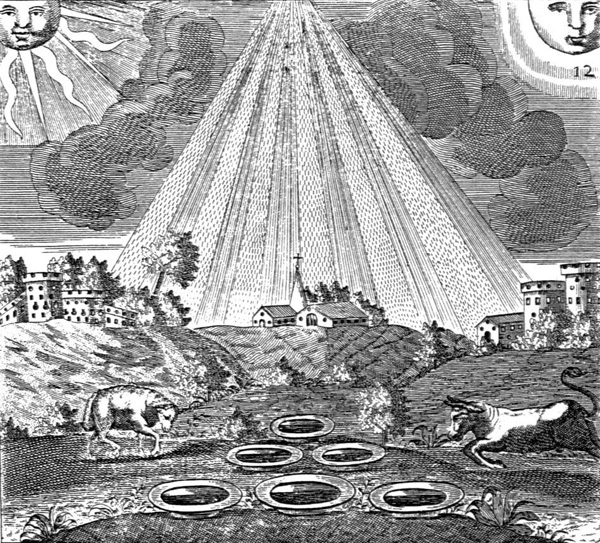
Sun-thickened walnut and linseed oil preparations.
Yesterday I put out a batch of linseed and walnut oil to thicken in the sun on lead trays.
For many years I made my own, but after Zecchi finally got their sun-thickened linseed oil to the right consistency I started using theirs. Store bought sun-thickened oils are usually ‘August’ oils however, meaning they put it out in the very hot summer months where it thickens very fast. This year I wanted to try a ‘Spring’ oil, which takes much longer to thicken, but should absorb more oxygen at the same time. My medium is one part sun-thickened linseed oil mixed with one part thinned-down Canada Balsam (cut 1:1 with turpentine) and I use a lot of it, so its important that the quality is very high.

Thickening oil in the Mutus Liber?
Years ago I stumbled across an old alchemical treatise called the ‘Mutus Liber’ , or ‘Silent Book’. Its called this as no one knows what exactly the book is about. One image stood out because it looked like they could have been thickening oil for a painting medium. The accompanying text said the ram and bull represented Aries and Taurus, and that the trays were put out in April and May to collect the creative energy of the Spring. Any little edge helps I suppose…
Marc,
Why lead trays? Would you mind going into a little more detail about how to do this and why this is the medium you depend on so much? Thanks, this is great stuff.
Marc Hanson
Marc (H),
If you like Marc’s answer and want to give it a go yourself you’ll likely need to try a roofing supplier for the lead sheets. Back in the 90’s I had to get mine from a firm in the NW corner of 394/94. Can’t remember the name just now however.
Hi Marc, I was always taught to thicken the oil on lead sheets so it absorbs some of the lead and becomes faster drying. Recently I’ve read a bit about how lead also homogenizes the drying of the paint layers as well.
Sun-thickening oil is really easy, you just put it in lead trays (some people use glass), cover it with a glass sheet in a manner so that debris and rain wont get in, but don’t seal it off from the air completely. Put some gauze where the air is passing if you do this in the countryside or the trays fill up with insects.
Then just leave it somewhere where it will get as much sun as possible, stirring once every few days so a skin doesn’t form. Depending on the heat and how thick you want it, the oil takes 10 days to 3 weeks to thicken.
Thank you Marc and Darren. I decided that for now I can’t separate the space I’d be grinding pigments for paint from my living area, but this is something that I’m going to do. I appreciate your willingness to share the information.
Good luck with the show in NY Marc! The paintings look fantastic.
Marc H
Instead of gauze try the material used by gardeners, it’s called row covers or floating row covers. It’s strong, it keeps out the bugs and lets in sun. It is a white semi-transparent polyester material used to protect young seedlings from insects and wind.
Can you thicken ANY oil this way?
I’ve only done walnut and linseed, but I don’t see why not.
Hi,
Do YOU…CLEANSE your oil before you begin the sun thickening?
If so, what method do you use?
You might find my website of interest to this subject.
Sincerely- Louis
I usually just clean it with water. I tried Doak’s bleaching clay for a year or two, but I couldn’t see much of a difference.
Hi Marc,
Thank you for your helpful blog! A few questions if you could help me out:
1. What kind of linseed oil works best (cold-pressed or the alkali refined)?
2. Does walnut oil have any advantages over linseed in as far as sun-thickened oils go?
3. Does one actually have to use lead trays? (Will copper make a suitable substitute?)
5. In making your medium, why do you use Canada balsam (instead of Larch/venice balsam)?
6. Is it critical to wash the oil first before sunning it?
7. Is there a store-bought thickened oil that you would recommend?
Thanks!
Rama
Hello Rama,
1. Use cold-pressed.
2. Walnut oil dries slower. Some find this to be an advantage, others a disadvantage. Personal choice.
3. If you don’t use lead, use plastic (or tupperware), the lead is to make the oil dry faster later. No reason that I know of to use copper.
5 (where is your 4?). Canada balsam is made for industry and it is always of a very high grade. Good larch turpentine is great to use as well, when I started painting it was hard to find a good supply but these days Kremer sells a straw-colored variety which works fine (Strasbourg turpentine also smells much nicer than Canada balsam, which can be nice when doing commissions in someones house). Venetian tends to be brown and looks rather suspect.
6. Not critical, but if you go through the trouble to thicken it, then the washing isn’t much work.
7. Zecchi’s is good, as is Kremer’s. Avoid Doak’s which I find way too thick (in fact, a lot of people get turned off of sun-thickened oil after they try his, which is totally unsuitable for a painting medium).
Hey Marc,
Thanks for the quick reply! I appreciate your taking time to give me advice.
BTW, 2 thumbs up for your works, way up.
Rama
Marc,
*Delightful* blog, thank you. Found you when googling “sun-thickended oil”. I live in a NYC apartment with no outdoor space – as you may imagine, all my sun oil has to be sourced elsewhere. Big props for the Zecchi link on that front (hoping they’d ship me some linseed sun oil if I ordered). The Mutus Liber is called such, btw, because there are no words in the book. Good call on your interpretation of the image; not only is your take incredibly pregnant with possibility, it’s probably also correct.
Hello Ridgely,
Thank you for the compliment. You should try the Kremer sun-thickened oil they sell in their shop in the garment district in NYC. It’s very good, I use it all the time when I’m in the U.S.
Much easier than ordering from Italy.
Hello, some really good advice on here….
Could you please tell me what is the best method for cleaning linseed oil? I know this question has already been asked but what is the process?
Cheers, Ernest
Hello Ernest.
I clean oil by putting 1L of oil in an empty 1.5L mineral water bottle and add .3L of water. Then I shake it gently every now and then for three days, then drain out the oil by poking a hole in the bottle just above the water line.
Hi, Thanks, I will give that a go. I heard that freezing the water was also a good method….
Keep up the good work.
Hello marc, I have a question about cleaning oil…. I brought some Kremer cold pressed linseed oil which contains mucilage. I cleaned it using the process you describe, however the oil is still very misty after letting it settle for several days. I used warm mineral water to clean it, is this the problem? do I need to use distilled water.
Also, can you let me know if its important to leave it in the sun whilst cleaning?
Thanks, Eddie
Good website and work by the way.
Hi Eddie, you can try changing the temperature dramatically. Put it somewhere really cold, then warm. You should always use cold water to avoid this problem. Usually the cloudiness settles in time though.
Hello Marc,
Think you have a great site.
I like to try out (old) mediums and techniques like you. A usefull method, for your alla prima outdoor paintings, might be oil-tempera. In fact it is painting with oilpaint but dries in minutes and stays well for ages.
About the Sun thickening linseed oil, I was wondering, does it come close to Standoil.
Regards,
Kees
Hello Kees. Thanks for the compliment. In answer to your question, stand oil is much more viscous and for me, unusable.
Hello Marc,
Sun-thickening Linseed and Walnut oil experience.
I did got the oil from Kremer. At first there was no change but when the sun came more I saw slowly the change in thickness.
In the last four weeks the oil started to become milkey, it was not transparent any longer.
It rains here often and despite the glass prevents the rain getting in, the moist was still high, maybe this was the reason.
It took 10 weeks to turn into a nicely thick oil.
Hello Kees, yes the milkyness is probably the humidity. It has happened to me as well. Need a bigger sheet of glass.
Hello Marc, am an Italian boy and reading in the manual “Handbook study” the oil cleaning system for the preparation of Sun-thickened linseed oil I did not understand what type of water you use, distilled water or water we drink every day or another type of water?
Thank you for all the information you provide on the blog and I can confirm Zecchi’s Sun-thickened linseed oil is really great.
Hi Andrea, regular tap water works fine.
Hi Marc,I have another question, reading the site Tad Spurgeon is written that Zecchi’s sun-thickened linseed oil turns out to be suboptimal since it was only as a combination of other oils, put the exact words of the site “The material marketed by Grumbacher as Sun Oil may have seen the sun at some point in it’s process, but is essentially a mixture of much slower drying vacuum bodied oils. Zecchi is unfortunately doing the same thing.” Now I’m undecided whether to trust the products Zecchi or not. What do you think? Finally, I would like to ask if Zecchi’s Damar Varnish is of good quality or not?
Thanks and good luck
I’ve never had a problem with it. Massimo makes it himself, I would be surprised if he would cut it with anything.
Hello Marc, sorry to bother you but I have to propose a technical question: given that lately in Italy the weather is always bad, I would like to ask you if the preparation of the sun thickened linseed oil linseed oil thickens due to the heat of the sun or due to sunlight? I ask this because I would have thought possibly to use the lamps that mimic sunlight to thicken the oil, do you think it can work?
Try using rain water, after separation heat gently for an hour to remove moisture.
Standoil dries slower as over 240 c oil produces fatty acids that slow down drying.
Sun thickened oil dries faster than raw oil. You can also pour water over your oil when doing the sun drying.
You can put 1 part of oil in 3 parts of rainwater and a rolling boil for 2 or 3 hours, with lid on or off. Then cool and separate, gently heat to drive out moisture. This method was used in merchant navy to obtain oil that lasted longer on the metal to stop rust.
Jacob